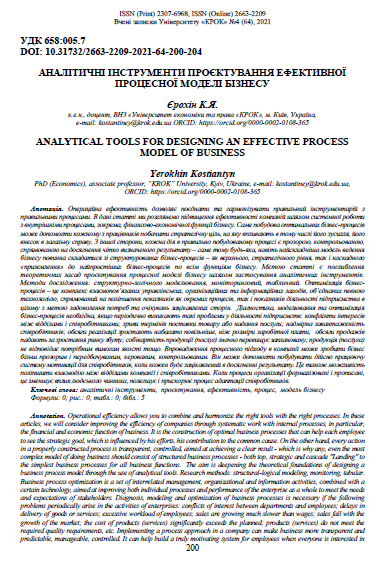ANALYTICAL TOOLS FOR DESIGNING AN EFFECTIVE PROCESS MODEL OF BUSINESS
DOI:
https://doi.org/10.31732/2663-2209-2021-64-200-204Keywords:
analytical tools, design, efficiency, process, business modelAbstract
Operational efficiency allows you to combine and harmonize the right tools with the right processes. In these articles, we will consider improving the efficiency of companies through systematic work with internal processes, in particular, the financial and economic function of business. It is the construction of optimal business processes that can help each employee to see the strategic goal, which is influenced by his efforts, his contribution to the common cause. On the other hand, every action in a properly constructed process is transparent, controlled, aimed at achieving a clear result - which is why any, even the most complex model of doing business should consist of structured business processes - both top, strategic and cascade "Landing" to the simplest business processes for all business functions. The aim is deepening the theoretical foundations of designing a business process model through the use of analytical tools. Research methods: structural-logical modeling, monitoring, tabular. Business process optimization is a set of interrelated management, organizational and information activities, combined with a certain technology, aimed at improving both individual processes and performance of the enterprise as a whole to meet the needs and expectations of stakeholders. Diagnosis, modeling and optimization of business processes is necessary if the following problems periodically arise in the activities of enterprises: conflicts of interest between departments and employees; delays in delivery of goods or services; excessive workload of employees; sales are growing much slower than wages; sales fall with the growth of the market; the cost of products (services) significantly exceeds the planned; products (services) do not meet the required quality requirements, etc. Implementing a process approach in a company can make business more transparent and predictable, manageable, controlled. It can help build a truly motivating system for employees when everyone is interested in achieving results. It is also an opportunity to improve the interaction between the company's departments and employees. When the processes of the organization are formalized and prescribed, it reduces the impact of the human factor, facilitates and accelerates the process of adaptation of employees.
Downloads
References
Cook S. Process improvement: a handbook for managers. Aldershot, Hampshire, England; Brookfield, Vt., USA: Gower, 1996. 162 p.
Halpin, J. F. Zero Defects: A New Dimension in Quality Assurance. New York : McGraw-Hill, 1966. 228 p.
Parmenter D. Key Performance Indicators. New Jersey, USA: John Wiley & Sons, inc., 2007. 233 p.
Костіна О. М. Діагностика та управління бізнес-процесами у контексті антикризового управління підприємством. Економічний науково-практичний журнал «Економіка і суспільство». 2017. № 10 С. 287- 297.
Harmon, Paul Business Process Change: A Managers Guide to Improving, Redesigning, and Automating Processes (The Morgan Kaufmann Series in Data Management Systems) Published by Morgan Kaufmann, 2003.



